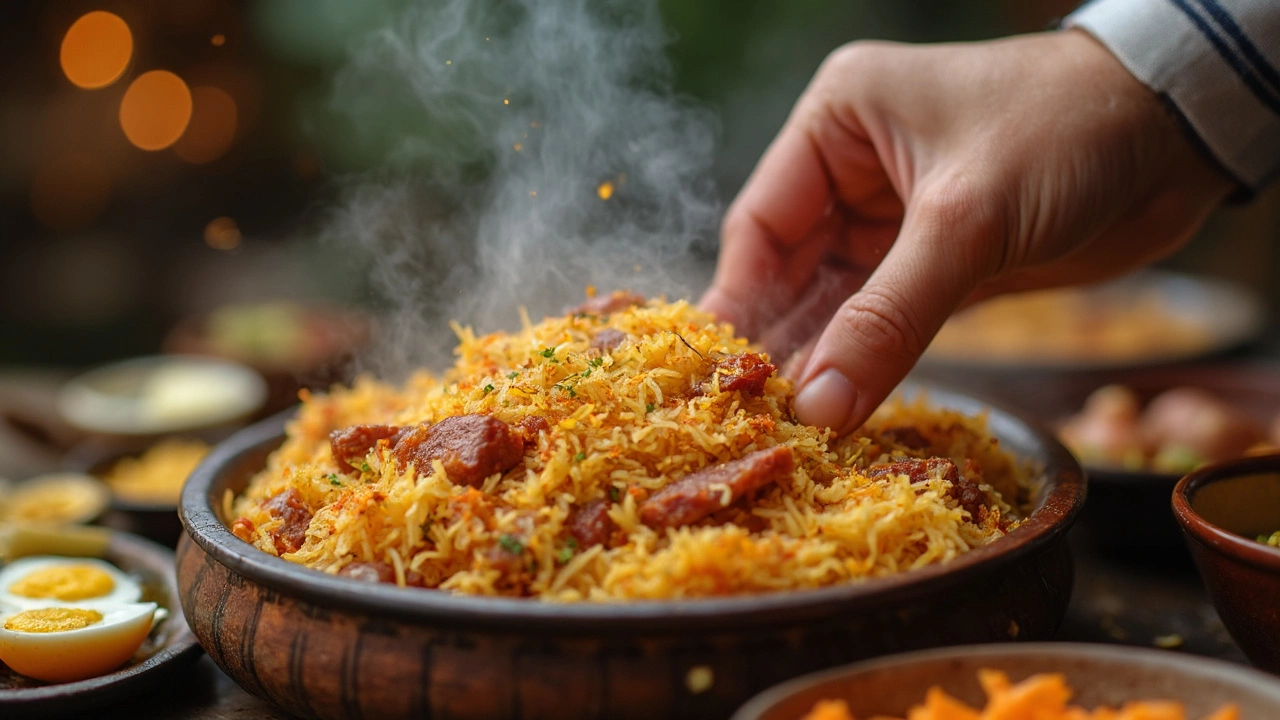If you’ve got a steaming plate of biryani in front of you and you’re not sure how to dig in, you’re definitely not alone. The fight over the right way to eat biryani can spark heated debates at family tables, food festivals, and WhatsApp groups—and the answer isn’t as simple as you might think. Some people grab a spoon without hesitation, others insist that using your hands is non-negotiable. Surprisingly, even the way you mix the rice and meat matters if you want the full flavor explosion.
People who grew up eating biryani have strong opinions. In Hyderabad, for example, folks often use their hands, arguing that you don’t get the true taste unless you touch the food. There’s actually a reason for this—your fingers help you feel the different textures and control each bite. But if you’re not comfortable or you’re at a work lunch and don’t want turmeric stains, don’t stress. Nobody’s going to judge you for using a spoon (well, maybe your grandmother will, but she’ll get over it).
- Why Eating Biryani Feels Special
- The Right Tools: Hands or Spoon?
- Mixing and Matching: Getting It Just Right
- Classic Sides and Extra Tips
Why Eating Biryani Feels Special
No other food gets a table buzzing quite like biryani. It’s not just about taste; there’s an entire culture and history mixed in every bite. Did you know biryani isn’t from just one region of India? There’s Hyderabadi, Kolkata, Lucknowi, and even versions from Pakistan and the Middle East. Each one has its fans, and each claims theirs is the only 'real' biryani. It’s friendly rivalry, but it shows just how seriously people take this dish.
For a lot of folks, biryani means celebration. Weddings, birthdays, big family gatherings—there’s almost always a giant pot of it on the menu. Some families even cook up biryani on Fridays as their little weekly party. You’ll rarely find anyone casually cooking it on a random Tuesday night; the process is too much of a project to not make it special.
What truly sets biryani apart? It’s the layers. You get marinated meat or veggies tucked between fluffy, aromatic rice, with just the right dose of spices. Every layer is built carefully, so when you dig in, every forkful or handful is a mash-up of flavors and textures.
Here’s something cool—there’s often a “biryani hierarchy” at the table. Everyone lunges for the meatier cuts or the best potato pieces first. In some families, the distribution of the top rice layer or the bottom 'khurchan' (those crispy bits at the bottom) is taken very seriously, almost like a family tradition in itself.
| Occasion | Biryani Popularity (%) |
|---|---|
| Weddings | 88 |
| Festivals | 75 |
| Large Family Meals | 82 |
| Casual Dinners | 23 |
All of this makes eating biryani feel like more than just lunch or dinner. It's a ritual that brings people together, with just the right amount of chaos and excitement tossed in. So yeah, there’s a bit of magic when a plate of biryani gets passed around.
The Right Tools: Hands or Spoon?
This is where things get interesting. There are people who won’t touch biryani with anything but their fingers, while others stick to a spoon—sometimes even a fork. So, which one’s right?
Traditionally, in countries like India, Pakistan, and Bangladesh, eating rice dishes like biryani with your hands is totally normal. Some believe your hands help you feel the warmth, graininess, and mix it right—making each mouthful a better combo of rice, meat, and masalas. Plus, science actually backs up the experience: there’s research saying that eating with your hands can boost your senses and even help digestion by signaling your gut that food’s on the way. That’s why at many South Asian dining tables, you’ll always find people enjoying their biryani by hand.
But spoons have their fans, too. People love that it’s quick, less messy (no fingers turning yellow), and feels more hygienic, especially in a restaurant—or when you’re in fancy clothes. Some top chefs in India’s biggest cities say that your comfort matters more than tradition, and honestly, there’s no taste police about it.
Here’s what most folks agree on:
- If you’re eating with your hands, use your right hand only. The left hand is considered unclean in most South Asian cultures.
- Always wash your hands before and after eating.
- For newbies, you can start with a spoon and try using your hands at home until you get the hang of it. It’s not a race.
Curious how people split on this? A recent survey of biryani fans in India found about 60% still eat biryani with their hands, while 40% go for a spoon. But don’t get caught up in peer pressure. The only rule that truly matters is to enjoy your food without making it weird for you or anyone around you.
Some people do a mix: they start mixing the layers with a spoon, then use their hand for the actual eating. Do what works for you. The real tragedy would be skipping the biryani altogether!

Mixing and Matching: Getting It Just Right
This is where biryani sparks big debates. Should you mix everything up, or is it better to eat each layer the way it’s served? If you ask biryani fans in Hyderabad or Kolkata, you’ll get totally different answers, but here’s what really matters: it’s all about getting the perfect bite.
Most biryani gets served in layers—fluffy rice on top, juicy meat or veggies in the middle, and that bottom bit called the 'dum' where all the spices settle. If you just scoop from the top, you miss out on the good parts (and your cousin next to you gets stuck with only meat or only rice). Mixing lightly—not mashing—lets you blend the rice, meat, and masala so you taste all the flavors in one mouthful.
Here’s how to do it right:
- Use a big spoon or your hand to gently lift rice from the sides and fold it toward the middle so the masala at the bottom gets shared.
- Don’t over-mix. You want some of each layer on your plate at the same time, but without losing the textures.
- Line up a bit of raita or curry on the edge of your plate—just a dab with each scoop amps up the taste without making things soggy.
If you’re making or serving biryani for a crowd, mix big pots with care before serving. In restaurants, they often mix lightly in the kitchen, but you can always stir it more on your own plate to find your happy balance.
Not sure how to split a plate? Just imagine this:
| Item | Amount per serving |
|---|---|
| Rice | 60% |
| Meat/Veggies | 30% |
| Masala and extras | 10% |
This combo keeps things balanced and makes every bite of biryani pop with flavor. Don’t forget to try a bit of all the layers—otherwise, you’re just eating plain rice, and where’s the fun in that?
Classic Sides and Extra Tips
Let’s get real—biryani by itself is already a star, but the right sides push it to a whole other level. The most common side? Hands down, it’s raita—a yogurt sauce with chopped onions, cucumber, and cilantro. The cool, tangy taste of raita tones down the spice and makes each bite of biryani feel fresh. Another classic is salad. Usually, it’s a simple mix: sliced onions, lemon wedges, maybe some green chilies. If you want to go old-school, try a hard-boiled egg or a boiled potato on the side. Both show up in South Indian biryani plates every day.
If you’re after the real restaurant vibe, don’t skip on a spicy gravy. In Hyderabad, you’ll get something called “mirchi ka salan”—a peanut and chili curry that’s honestly made for biryani. Some spots serve curry with extra masala or a tangy tomato chutney. In Kolkata, you’ll usually spot a potato tucked right inside the biryani—no joke, locals argue the potato is just as important as the meat.
- Raita keeps things cool and creamy, and it’s packed with probiotics if you care about gut health.
- Simple salad (onion, cucumber, lemon) cuts through the oil and helps balance the meal.
- Hard-boiled eggs or spiced boiled potatoes bump up the protein and keep you full longer.
- Spicy gravies and chutneys add serious flavor—try a spoonful with each bite for variety.
If you’re hosting, keep a jug of cold water or buttermilk handy; biryani can be spicy, and not everyone handles chili like a pro. Also, don’t fill up your plate too much at once. Biryani tastes best when warm, so go for small, repeated helpings.
One tip from regulars: Don’t mix in all the raita at the start. Scoop a bit with every spoonful so nothing gets too soggy. If there’s leftover biryani (rare, but it happens), it actually tastes better the next day after the flavors settle in. Just don’t microwave it dry—sprinkle some water, cover with a plate, and heat gently.
Here’s a quick look at the most popular biryani sides by region:
| Region | Top Side Dish | Why It Works |
|---|---|---|
| Hyderabad | Mirchi ka salan, raita | Cools down spice, adds tang |
| Kolkata | Boiled potato, salad | Soaks up extra masala |
| Chennai | Egg, onion raita | Protein boost, mild flavor |
| Mumbai | Salad, lemon | Fresh crunch, zesty finish |
Next time you’re faced with a plateful, load up on sides that work for you—but never drown the biryani. Let the rice and meat shine with every bite, and use the extras to mix things up. That’s how you hit biryani bliss.
